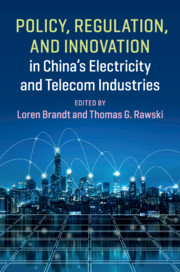Book contents
- Policy, Regulation, and Innovation in China’s Electricity and Telecom Industries
- Policy, Regulation, and Innovation in China’s Electricity and Telecom Industries
- Copyright page
- Contents
- Figures
- Tables
- Contributors
- Acknowledgments
- Abbreviations
- Map of China
- 1 Policy, Regulation, and Innovation in China’s Electricity and Telecom Industries
- 2 China’s Electricity and Communications Regulation in Global Context
- 3 Local Government and Firm Innovation in China’s Clean Energy Sector
- 4 Technology Integration in China’s Electricity System: Central Targets and Local Challenges
- 5 When Global Technology Meets Local Standards
- 6 The Search for High Power in China: State Grid Corporation of China
- 7 Growth, Upgrading, and Limited Catch-Up in China’s Semiconductor Industry
- 8 Growth, Upgrading, and Excess Cost in China’s Electric Power Sector
- 9 China’s Development of Wind and Solar Power
- 10 Capability Upgrading and Catch-Up in Civil Nuclear Power: The Case of China
- Index
- References
6 - The Search for High Power in China: State Grid Corporation of China
Published online by Cambridge University Press: 08 June 2019
- Policy, Regulation, and Innovation in China’s Electricity and Telecom Industries
- Policy, Regulation, and Innovation in China’s Electricity and Telecom Industries
- Copyright page
- Contents
- Figures
- Tables
- Contributors
- Acknowledgments
- Abbreviations
- Map of China
- 1 Policy, Regulation, and Innovation in China’s Electricity and Telecom Industries
- 2 China’s Electricity and Communications Regulation in Global Context
- 3 Local Government and Firm Innovation in China’s Clean Energy Sector
- 4 Technology Integration in China’s Electricity System: Central Targets and Local Challenges
- 5 When Global Technology Meets Local Standards
- 6 The Search for High Power in China: State Grid Corporation of China
- 7 Growth, Upgrading, and Limited Catch-Up in China’s Semiconductor Industry
- 8 Growth, Upgrading, and Excess Cost in China’s Electric Power Sector
- 9 China’s Development of Wind and Solar Power
- 10 Capability Upgrading and Catch-Up in Civil Nuclear Power: The Case of China
- Index
- References
Summary
There are long-held assumptions that Chinese firms, especially state-owned enterprises (SOEs), cannot innovate because distorted incentive structures discourage them from taking risks. This paper disputes this assumption. It explains why and how the State Grid Corporation of China (SGCC) engaged in technology innovation that propelled this state-owned giant into the top rank of global leaders in the development of ultra-high-voltage electrical transmission systems. Government policies of SOE reform and technology innovation provided incentive structures within which SOEs operated; yet the outcomes could vary greatly. This paper explains how SGCC’s entrepreneurial managers formulated an ambitious innovation strategy, convinced government leaders to include advanced UHV technology in plans for indigenous innovation, and then implemented a risk-laden approach deploying an open-innovation strategy – project-driven, inclusive, and collaborative. SGCC worked with a range of players: universities, research institutions, suppliers and multinational corporation (MNCs), all on SGCC’s terms. Successful R&D produced designs and equipment that enabled SGCC to build and operate long-distance transmission lines that achieved unprecedented scale and efficient energy utilisation. SGCC’s technical accomplishments reshaped the rules of the game in research with universities and the relationship with electric equipment manufacturers.
Keywords
- Type
- Chapter
- Information
- Publisher: Cambridge University PressPrint publication year: 2019
References
- 5
- Cited by



